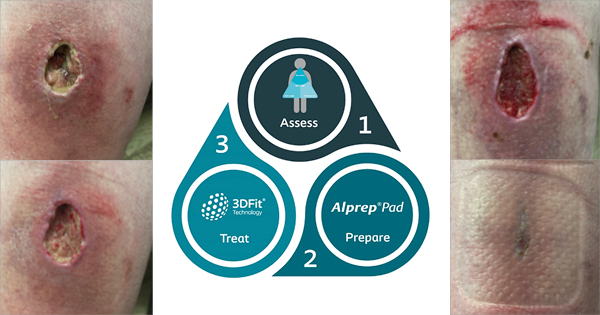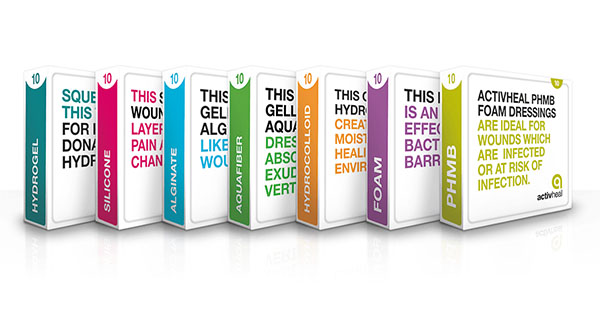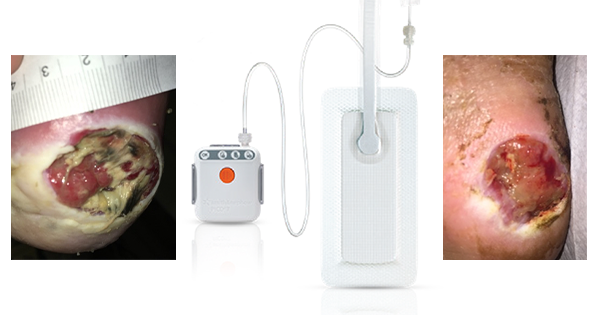Chronic wounds present many challenges to the nurse and patient. In wounds that are producing large amounts of fluid, devising strategies to minimise the impact on the patients physical and psychosocial wellbeing can be particularly demanding. Flivasorb® and Flivasorb® Adhesive are superabsorbent dressings particularly suited to wounds that are exuding heavily. This how to guide focuses on how Flivasorb and Flivasorb Adhesive work and are beneficial in such patients.
What is exudate?
Exudate is derived from the fluid that has leaked from capillaries into body tissues around the wound. In acute wounds, exudate stimulates and supports healing by:
- aiding the migration of cells and immune and growth factors across the wound bed
- supplying essential nutrients for the cells
- assisting dead or damaged tissue to separate from good tissue (autolysis) (WUWHS, 2007).
However, in chronic wounds, the composition of exudate is different with higher levels of matrix metalloproteinases (MMPs), which break down healthy tissue as well as prolong the inflammatory response. This may have harmful effects that prevent healing and even cause further damage. High exudate production can have a number of causes, eg sustained inflammation, local infection, venous insufficiency, lymphatic disease (eg lymphoedema), congestive cardiac failure, renal or hepatic failure, medication, malnutrition, heat, or reduced willingness or ability to cooperate with treatment (eg compression therapy) (Gardner, 2012). The volume of exudate is also linked to the size of the wound.
Dressings and exudate management
The main roles of dressings in exudate management are to absorb excess exudate while keeping the wound bed sufficiently moist to enhance healing. However, the wound should not be kept so wet that the surrounding normal skin becomes soggy (macerated) and prone to damage.
Consequences of poor exudate management
- delayed healing
- discomfort or pain
- leakage, soiling and odour – these are a particular cause of distress and concern for affected patients (Jones et al, 2008)
- changes in the normal skin around the wound such as maceration and excoriation where the skin becomes softened and starts to break down – these can contribute to wound pain and may cause the wound to enlarge (Benbow and Stevens, 2010)
- high frequency of dressing change causing increased inconvenience to the patient and increased use of healthcare resources and nursing time (Davis, 2012; Menon, 2012; WUWHS, 2007)
- protein loss and fluid/electrolyte imbalance
- reduced concordance with treatment such as compression bandaging or leg elevation.
What is Flivasorb?
Flivasorb is a superabsorbent dressing that is indicated for the management of moderately to heavily exuding wounds, including pressure ulcers, leg ulcers, diabetic ulcers, postoperative wounds healing by secondary intention, laparotomy wounds, fistulae/sinuses and superficial or partial thickness burns.
Flivasorb has a polyethylene wound contact layer which minimises wound adherence. The core is made of cellulose and superabsorbent polymer (sodium polyacrylate) particles. The outer layer is breathable and prevents leakage (Tadej, 2009).
What is Flivasorb Adhesive?
Flivasorb Adhesive is the same as Flivasorb, but has an adhesive border (Figure 1). This means that the dressing requires no additional fixation, and is particularly useful for areas of the body where it may be difficult to apply a dressing that requires secondary fixation, eg the sacrum or groin.
How do they work?
Flivasorb and Flivasorb Adhesive absorb exudate through the wound contact layer into the core of the dressing. The dressing is able to absorb upto 20 times its own weight in fluid. When liquid enters the core, it attaches to the superabsorbent polymers and forms a gel, which causes the dressing to swell. The formation of a gel means that, unlike with some foam dressings, fluid is not released if the dressing is compressed. The gelling action also traps unwanted components of the exudate such as bacteria, proteases and inflammatory mediators within the dressing (Wiegand et al, 2009).
Choosing a dressing to manage exudate
A wide variety of wound dressings is available and choice of a dressing will take into account a number of factors, including the level of exudate production, which can change during the healing process. The aim of exudate management is to maintain a moist wound bed to aid healing, while keeping exudate away from the skin. If a dressing of too high absorbency is selected, the wound bed may be dried out; if the dressing is not sufficiently absorbent, the skin surrounding the wound may become macerated and leakage may occur, causing pain and distress for the patient (Gardner, 2012).
Foams vs superabsorbents
For wounds that are highly exuding, high absorbency is required to make dressing change frequency manageable and to avoid periwound skin problems. Traditionally, foam dressings have been used to manage high exudation. However, in some cases the fluid handling capacity may be less than optimal, necessitating more frequent dressing changes, and an inability to retain fluid under pressure, eg under compression bandaging.
The choice of wound dressing should be made in the context of the aetiology of the wound, the status of the wound, and the other needs of the patient.
Advantages of using Flivasorb and Flivasorb Adhesive
Flivasorb and Flivasorb Adhesive have properties that mean they fit well with the profile of an ideal dressing for the management of high exudation (Adderley, 2008; Stephen-Haynes, 2011).
- They are able to absorb and retain high volumes of exudate. This means that they have the potential for extended wear time and reduced dressing change frequency. Importantly, the high absorption and retention reduces the likelihood of periwound skin damage.
- The dressings are comfortable and easy to apply, and due to its adhesive border Flivasorb Adhesive does not require secondary fixation.
- Both dressings may be used as the primary dressing, or as a secondary dressing with an appropriate antibacterial dressing on infected wounds or over a cavity dressing for deeper wounds.
- The outer layer of the dressings prevents strikethrough and the dressings are constructed to stay intact even when saturated. The non-adhesive wound contact layer minimises trauma and pain on removal of the dressings.
- Both retain the fluid they have absorbed when under pressure, such as under compression bandaging. This reduces the risk of maceration or excoriation with, for example, sacral pressure ulcers or venous leg ulcers. This makes Flivasorb ideal for use in the management of venous leg ulcers where compression bandaging is being used and Flivasorb Adhesive ideal for use in the management of sacral pressure ulcers due to the excellent fixation it provides in such awkward areas.
Tips on using Flivasorb and Flivasorb Adhesive
Indications
- Flivasorb and Flivasorb Adhesive are indicated for moderately to highly exuding wounds.
- Flivasorb and Flivasorb Adhesive may be used under compression. Flivasorb Adhesive should only be used under compression bandaging if there is a specific requirement for an adhesive dressing in this situation, but can be very convenient to use under compression hosiery.
- Flivasorb or Flivasorb Adhesive can be used on critically colonised and infected wounds as they have bacteriostatic properties (Weigand et al, 2009). Antimicrobial dressings and/or systemic antibiotic therapy may also be required and a thorough patient assessment should be carried out.
Precautions and contraindications
- Do not use Flivasorb or Flivasorb Adhesive on patients sensitive to any of the components of the dressings.
- If using oily ointments on a wound or surrounding skin where Flivasorb or Flivasorb Adhesive is used, this may affect the absorbency/adhesion capability of the dressing, where it is in contact with the ointment.
- Do not use Flivasorb in wound tunnels because the dressing will expand in the tunnel and may be difficult to remove.
- Do not use Flivasorb or Flivasorb Adhesive on lightly or non-exuding wounds.
Applying the dressing:
- The wound should be cleansed according to local protocols and the wound edges patted dry before application of Flivasorb or Flivasorb Adhesive.
- Antiseptic cleansing solutions can be used with Flivasorb and Flivasorb Adhesive.
- Flivasorb should be applied with the blue side facing away from wound.
- Flivasorb should extend beyond the wound edge by about 2-3cm.
- Flivasorb Adhesive should extend beyond the wound edge by about 4-5cm.
- Apply Flivasorb Adhesive without stretch to allow the dressing room to expand and prevent tension on the surrounding skin when the dressing absorbs exudate and swells.
- Do not cut Flivasorb or Flivasorb Adhesive because the absorbent contents of the dressing will come out.
- Flivasorb will require additional secondary fixation, but Flivasorb Adhesive does not.
Dressing change frequency
Flivasorb and Flivasorb Adhesive should be changed when the absorbent capacity of the dressing has been reached. This may be after 2-3 days, but in some cases more or less frequent changes may be necessary. (Adapted from Morris, 2009.)
Evidence for using Flivasorb
A number of observational studies, case series and case studies that discuss the use of Flivasorb and Flivasorb Adhesive in a range of wound types have been reported. These studies support the effectiveness of Flivasorb in the management of highly exuding wounds in reducing maceration and dressing change frequency. Dowsett (2008) advised that frequent dressing changes can lead to periwound damage by stripping the skin. It is also important to remember that for many patients the removal and/or changing of a dressing is the most common trigger for pain in chronic wounds (Meaume et al, 2004).
Clinical benefits
Another study examined the use of Flivasorb for 7 days in 15 patients with highly exuding wounds. At the start of the study, seven patients had periwound maceration, but this had fallen to one patient by the end of the study. In addition, after three days, dressing change frequency was reduced from daily to twice weekly in 12 patients (Faucher et al, 2012).
An evaluation Flivasorb Adhesive in 11 patients found the product easy to apply. Patients reported comfort during wear to be good to excellent, and reported low or almost no pain during dressing changes (Mustafi et al, 2012). Further case studies have confirmed that Flivasorb is effective under compression bandaging for venous leg ulceration (Collarte and Lear, 2010) and lymphoedema (Billingham, 2009; Lewis, 2010).
Cost benefits
In a prospective four week study of 16 patients with highly exuding wounds, change of treatment to Flivasorb resulted in a reduction in dressing change frequency by 1-2 visits per week, which gave considerable cost savings. The authors calculated that by reducing daily dressing changes (at a cost of £8,736 per year – based on £24 per change) to twice weekly, a significant saving of £6,240 per year is made for each patient that does not heal within the year for dressing costs alone (Verrall et al, 2010).
Maximising patient quality of life
In the community setting where dressing changes are generally forward planned, patients need to know that the dressing selected will stay in place for the duration of time between dressing changes. Anxiety levels can be raised if patients have to contact the district nurses between planned dressing changes as they often assume that something must have gone wrong. They also need to be confident that the dressing will contain the exudate ensuring that they are not left either feeling self-conscious because there is strikethrough, with the potential risk of malodour, or with extra washing because the wound has leaked onto the bedclothes (Jones et al, 2008). Patient comfort and acceptability are important factors when determining success or otherwise of a treatment regimen.
References
- Adderley U (2008) Wound exudate: what it is and how to manage it. Wound Essentials 3: 8-13
- Benbow M, Stevens J (2010) Exudate, infection and patient quality of life. Br J Nurs 2010; 19(20): S20, S32-6
- Billingham R (2009) The management of lymphorrhoea with Flivasorb and Actico. Poster at: Wounds UK conference, Harrogate (UK)
- Collarte A, Lear Z (2010) Use of superabsorbent and antimicrobial dressings under compression. Poster at: Wounds UK Conference, Harrogate (UK)
- Davies P (2012) Exudate assessment and management. Wound Care S18-24
- Dowsett C (2008) Exudate management: a patient-centred approach. J Wound Care 17(6): 249-52
- Faucher N, Safar H, Baret M, et al (2012) Superabsorbent dressings for copiously exuding wounds. Br J Nurs 21(12): S22-28
- Gardner S (2012) Managing high exudate wounds – how to guide. Wound Essentials 7(1). Available at: https://wounds-uk.com/pdf/content_10474.pdf.
- Jones JE, Robinson J, Barr W (2008) Impact of exudate and odour from chronic venous ulceration. Nurs Standard 22(45): 53-4,56,58
- Lewis M (2010) Chronic oedema – a patient’s perpetual journey for treatment. Poster at: European Wound Management Association (EWMA), Geneva (Switzerland)
- Meaume S, Telom L, Lazareth I, et al (2004) The importance of pain reduction through dressing selection in routine wound management: the MAPP study. J Wound Care 13: 409-13
- Menon J (2012) Managing exudate associated with venous leg ulceration. Wound Care S6-16
- Morris C (2009) Flivasorb® and the management of exudate. Wounds UK 5(2): 63-66
- Mustafi N, Hampton S, Krähenbühl S, et al (2012) First evaluation of an adhesive superabsorber dressing on 11 patients with wounds of different aetiologies and exudate levels. Poster at: 22nd Conference of the European Wound Management Association (EWMA), Vienna (Austria)
- Stephen-Haynes J (2011) Managing exudate and the key requirements of absorbent dressings. Br J Community Nurs 16(3 Suppl): S44-49.
- Tadej M (2009) The use of Flivasorb in highly exuding wounds. Br J Nurs 18(5): S38-42
- Verrall D, Coulbourn A, Bree-Aslan C (2010) Evaluating a super-absorbent dressing (Flivasorb) in highly exuding wounds. Br J Nurs 19(7); 449-53
- Wiegand C, Abel M, Ruth P, Hipler U-C (2009a) Antibacterial and antifungal effect of polyacrylate superabsorbers. Poster at: Wounds UK Conference,Harrogate (UK)
- Wiegand C, Abel M, Ruth P, Hipler U-C (2009b). A polyacrylate-superabsorber inhibits the formation of ROS/RNS in vitro. Poster at: Wounds UKConference, Harrogate (UK)
- Wiegand C, Abel M, Ruth P, Hipler U-C (2009c). Polyacrylate-superabsorber binds inflammatory proteases in vitro. Poster at: Wounds UK Conference,Harrogate (UK)
- World Union of Wound Healing Societies (WUWHS) (2007) Principles of best practice: Wound exudate and the role of dressings. A consensus document. London: MEP Ltd. Available at: www.woundsinternational.com
Contributor: June Jones, Independent Nurse Consultant, Associate
Tutor, Edge Hill University, Ormskirk, Lancashire






